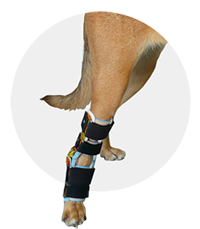Hock Orthosis
The hock is one of the three main joints in the hindlimb and is located just proximal to the paw.
Hock orthoses can be used to manage a variety of joint abnormalities including Achilles tendon injuries, and
This type of orthotic device may be used in place of surgery, when surgical repair is not a possible or desired option, or it may be used at some distance after surgery if the procedure did not create the desired level of stability. In some cases, hock orthoses are used as post-operative support to replace the traditional system of bandaging with a splint.
A hock orthosis will cross the hock joint and extend above and below. In cases of mild angular changes, the support may end at the top of the paw, leaving the foot free to contact the ground. In more severe cases it is necessary to extend the support under the paw to properly support the joint and to spread out the pressure in the brace.
An orthosis can be made to completely immobilize the joint, or to allow a controlled range of motion, such as limiting flexion but allowing extension.
Neurological deficits in the hindlimb (such as those presenting with Sciatic nerve injury) may also benefit from the positional support and protection of a hock orthosis. While waiting for the progression of any neurological recovery, a hock brace can keep the paw and the hock joint in functional positions so that the lower limb can be more easily brought forward. It also serves to keep the
Hock orthoses can be used to manage a variety of joint abnormalities including Achilles tendon injuries, and
varusinward angulation of the limb segment below a joint
or valgus deviationsoutward angulation of the limb segment below a joint
of the joint.
This type of orthotic device may be used in place of surgery, when surgical repair is not a possible or desired option, or it may be used at some distance after surgery if the procedure did not create the desired level of stability. In some cases, hock orthoses are used as post-operative support to replace the traditional system of bandaging with a splint.
A hock orthosis will cross the hock joint and extend above and below. In cases of mild angular changes, the support may end at the top of the paw, leaving the foot free to contact the ground. In more severe cases it is necessary to extend the support under the paw to properly support the joint and to spread out the pressure in the brace.
An orthosis can be made to completely immobilize the joint, or to allow a controlled range of motion, such as limiting flexion but allowing extension.
Neurological deficits in the hindlimb (such as those presenting with Sciatic nerve injury) may also benefit from the positional support and protection of a hock orthosis. While waiting for the progression of any neurological recovery, a hock brace can keep the paw and the hock joint in functional positions so that the lower limb can be more easily brought forward. It also serves to keep the
dorsalon the dorsum or upper side
aspect of the foot protected from skin abrasions. It is important to note that to use a hock orthosis in this situation the dog must have some control of the stifle and the hip joint in order to be able to advance the lower leg forward.

